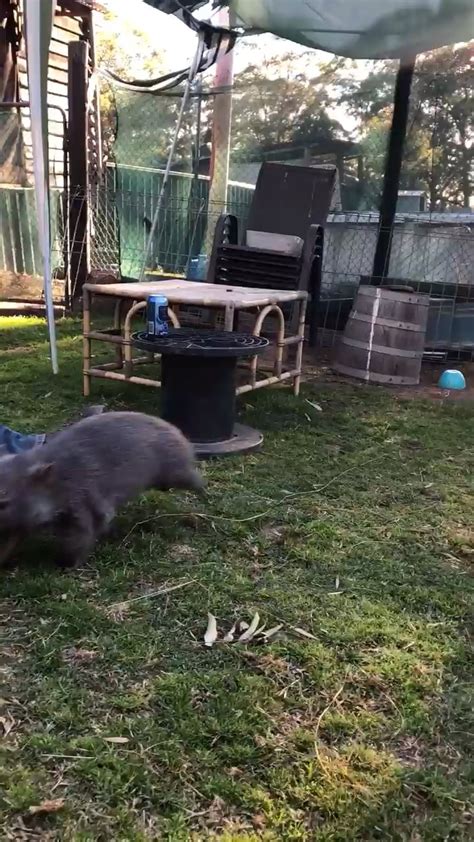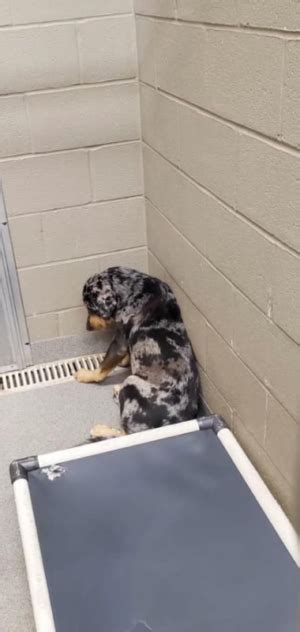
A rescued wombat joey named George is captivating the internet with his infectious bursts of energy, affectionately known as “zoomies,” at the Australian Reptile Park. The adorable displays of unbridled joy are melting hearts worldwide, showcasing the lighter side of wildlife rehabilitation.
George, a southern hairy-nosed wombat, has become a social media sensation thanks to videos documenting his enthusiastic sprints and playful antics within the park’s nurturing environment. Discovered as an orphan, George’s journey from vulnerability to thriving is a testament to the dedicated care provided by the park’s staff. His story not only raises awareness about wombat conservation but also highlights the emotional bonds that can form between humans and animals.
The Australian Reptile Park, located on the Central Coast of New South Wales, is renowned for its conservation efforts and interactive wildlife experiences. George’s presence has further amplified the park’s mission to educate the public about the importance of protecting Australia’s unique fauna.
George’s story began when he was found orphaned, highlighting the threats facing wombat populations, including habitat loss and vehicle collisions. The Australian Reptile Park has since provided George with a safe and enriching environment, simulating the natural conditions he would experience in the wild. According to park officials, George’s zoomies are a sign of his healthy development and contentment. These energetic episodes typically involve short bursts of high-speed running, playful hops, and general expressions of exuberance.
“George is thriving here at the park, and his zoomies are a clear indication of his happiness and well-being,” stated a spokesperson for the Australian Reptile Park. “It’s incredibly rewarding to see him grow and develop, knowing that we’re providing him with the best possible care.”
The park has shared numerous videos of George’s zoomies on its social media channels, quickly amassing a large and devoted following. Viewers from around the globe have expressed their admiration for George, praising his resilience and the dedication of the park’s staff. Comments range from expressions of pure delight to pledges of support for wombat conservation efforts.
Wombats are native to Australia and are known for their stout bodies, powerful claws, and burrowing habits. They play a crucial role in maintaining the health of their ecosystems by aerating the soil and dispersing seeds. The southern hairy-nosed wombat, in particular, is listed as a near-threatened species, making George’s story even more poignant.
The Australian Reptile Park actively participates in various conservation programs aimed at protecting wombats and other native Australian animals. These programs include habitat restoration, breeding initiatives, and public education campaigns. By sharing George’s story, the park hopes to inspire greater awareness and support for these vital conservation efforts.
Beyond his captivating zoomies, George’s daily life at the park involves a carefully curated routine designed to promote his physical and mental well-being. He receives a balanced diet consisting of native grasses, vegetables, and specialized wombat pellets. His enclosure is designed to mimic a natural burrow, providing him with a secure and comfortable space to rest. The park’s keepers also engage in regular enrichment activities to stimulate George’s curiosity and keep him mentally engaged.
These enrichment activities include providing George with novel objects to explore, such as branches, logs, and toys. The keepers also use positive reinforcement techniques to encourage George to interact with them and participate in training exercises. This not only helps to build a strong bond between George and his keepers but also prepares him for any necessary veterinary procedures.
The popularity of George’s zoomies has also had a positive impact on the Australian Reptile Park. The park has reported a significant increase in visitors since George’s videos went viral. Many visitors are eager to catch a glimpse of George in person and learn more about the park’s conservation efforts. This increased attention has allowed the park to expand its programs and further enhance its commitment to protecting Australian wildlife.
The story of George the wombat serves as a heartwarming reminder of the importance of wildlife conservation and the positive impact that dedicated individuals and organizations can have on the lives of vulnerable animals. His infectious zoomies are not only a source of entertainment but also a powerful symbol of hope and resilience. As George continues to thrive at the Australian Reptile Park, his story will undoubtedly inspire others to take action and support the protection of wombats and other endangered species.
Detailed Background Information on Wombats and Conservation Efforts
Wombats are stout, muscular marsupials native to Australia. They are renowned for their burrowing abilities and their cube-shaped droppings, a unique characteristic among mammals. There are three extant species of wombats: the common wombat (Vombatus ursinus), the southern hairy-nosed wombat (Lasiorhinus latifrons), and the northern hairy-nosed wombat (Lasiorhinus krefftii).
The southern hairy-nosed wombat, the species to which George belongs, is found in semi-arid and arid regions of southern Australia. They are distinguished by their soft, silky fur, pointed ears, and hairy noses. These wombats are primarily nocturnal and spend their days in elaborate burrow systems called warrens. Warrens can consist of multiple interconnected burrows, providing shelter from predators and extreme weather conditions.
Southern hairy-nosed wombats play a vital role in their ecosystems. Their burrowing activities help to aerate the soil, improving water infiltration and promoting plant growth. They also disperse seeds as they forage for food, contributing to the diversity of plant species in their habitat.
However, southern hairy-nosed wombats face a number of threats, including habitat loss, fragmentation, and degradation due to agriculture, urbanization, and mining activities. They are also vulnerable to vehicle collisions, predation by introduced species such as foxes and wild dogs, and competition for resources with livestock. Climate change is also posing an increasing threat to wombat populations, as droughts and heatwaves can reduce the availability of food and water.
The conservation status of the southern hairy-nosed wombat is currently listed as near-threatened by the International Union for Conservation of Nature (IUCN). This means that the species is close to qualifying for or is likely to qualify for a threatened category in the near future. The northern hairy-nosed wombat, on the other hand, is critically endangered, with only a few hundred individuals remaining in the wild.
Numerous organizations and government agencies are working to protect wombats and their habitats. These efforts include:
- Habitat Restoration: Restoring degraded habitats by planting native vegetation and removing invasive species.
- Protected Areas: Establishing and managing national parks and reserves to protect important wombat habitats.
- Research and Monitoring: Conducting research to better understand wombat ecology, behavior, and threats. Monitoring wombat populations to track their trends and assess the effectiveness of conservation efforts.
- Community Engagement: Educating the public about wombats and their importance, and encouraging community participation in conservation activities.
- Breeding Programs: Establishing captive breeding programs to increase wombat populations and provide animals for reintroduction into the wild.
- Mitigation Measures: Implementing measures to reduce the impact of human activities on wombats, such as building wildlife corridors under roads and reducing the use of pesticides.
The Australian Reptile Park plays an important role in wombat conservation through its rescue, rehabilitation, and education programs. The park provides a safe haven for orphaned and injured wombats, providing them with the care they need to recover and return to the wild. The park also educates visitors about wombats and their conservation challenges, inspiring them to take action to protect these unique animals.
The Role of Social Media in Wildlife Conservation
The story of George the wombat highlights the power of social media in raising awareness about wildlife conservation. By sharing videos and photos of George’s zoomies, the Australian Reptile Park has been able to reach a global audience and generate significant interest in wombat conservation.
Social media platforms such as Facebook, Instagram, and Twitter provide a powerful means for conservation organizations to communicate with the public, share information about their work, and mobilize support for their initiatives. Social media can be used to:
- Raise Awareness: Share information about endangered species, habitat loss, and other conservation issues.
- Educate the Public: Provide educational resources about wildlife and their ecosystems.
- Inspire Action: Encourage people to take action to protect wildlife, such as donating to conservation organizations, volunteering their time, or making sustainable lifestyle choices.
- Mobilize Support: Organize online campaigns to raise awareness about specific conservation issues and advocate for policy changes.
- Connect with Supporters: Build relationships with supporters and create a community of people who are passionate about wildlife conservation.
- Fundraise: Raise funds for conservation projects through online donations and crowdfunding campaigns.
The use of social media in wildlife conservation is not without its challenges. It is important to ensure that information shared on social media is accurate and reliable. It is also important to be mindful of the potential for negative impacts, such as the spread of misinformation or the exploitation of wildlife for entertainment purposes.
However, when used responsibly, social media can be a powerful tool for raising awareness about wildlife conservation and inspiring action to protect the planet’s biodiversity. The story of George the wombat is a testament to the potential of social media to connect people with wildlife and promote a greater appreciation for the natural world.
Expanding on Wombat Behavior and Diet
Wombats are primarily herbivores, and their diet consists mainly of native grasses, roots, herbs, bark, and other vegetation. Their strong teeth and powerful jaws are well-suited for grinding tough plant material. Wombats are also highly efficient at extracting water from their food, allowing them to survive in arid and semi-arid environments.
The digestive system of a wombat is adapted to process large amounts of fibrous plant material. They have a long digestive tract and a specialized cecum, a pouch-like structure that contains bacteria that help to break down cellulose. Wombats also practice coprophagy, the consumption of their own feces, to further extract nutrients from their food.
Wombats are generally solitary animals, except during the breeding season. They communicate with each other through scent marking, vocalizations, and body language. Wombats are known for their territorial behavior, and they will defend their burrows and foraging areas from other wombats.
The “zoomies” exhibited by George the wombat are a common behavior among many animals, particularly young ones. These bursts of energy are often triggered by excitement, playfulness, or a need to release pent-up energy. Zoomies typically involve short bursts of high-speed running, jumping, and other energetic movements.
In wombats, zoomies may also serve a functional purpose, such as helping them to explore their environment, develop their motor skills, and build their physical strength. The zoomies exhibited by George at the Australian Reptile Park are a sign of his healthy development and contentment.
Detailed Discussion on the Australian Reptile Park’s Role in Conservation
The Australian Reptile Park is a leading conservation organization dedicated to protecting Australian wildlife. The park is home to a wide variety of native animals, including wombats, kangaroos, koalas, snakes, lizards, and birds.
The park’s conservation efforts include:
- Rescue and Rehabilitation: Rescuing and rehabilitating injured, orphaned, and displaced animals.
- Breeding Programs: Participating in breeding programs for endangered species.
- Education Programs: Educating the public about Australian wildlife and conservation issues.
- Research: Conducting research on Australian wildlife to better understand their ecology and behavior.
- Habitat Restoration: Restoring degraded habitats to provide suitable habitat for wildlife.
- Community Engagement: Engaging with local communities to promote conservation awareness and action.
The Australian Reptile Park works closely with government agencies, other conservation organizations, and local communities to achieve its conservation goals. The park is committed to providing the highest standards of animal care and welfare.
The park’s education programs are designed to inspire a love of nature and a commitment to conservation. The park offers a variety of educational programs for schools, community groups, and the general public. These programs include guided tours, interactive exhibits, and educational presentations.
The Australian Reptile Park is a valuable resource for the community and plays an important role in protecting Australian wildlife. The park’s commitment to conservation is evident in its programs, its staff, and its dedication to providing a safe and enriching environment for its animals.
Ethical Considerations in Wildlife Tourism and Social Media
While the popularity of George the wombat has brought positive attention to the Australian Reptile Park and its conservation efforts, it is important to consider the ethical implications of wildlife tourism and the use of social media in promoting wildlife conservation.
Wildlife tourism can have both positive and negative impacts on wildlife. On the one hand, it can generate revenue for conservation efforts and raise awareness about the importance of protecting wildlife. On the other hand, it can also lead to habitat disturbance, stress to animals, and the spread of disease.
It is important for wildlife tourism operators to adhere to ethical guidelines that prioritize the welfare of animals and minimize the negative impacts of tourism. These guidelines should include:
- Respecting Animal Welfare: Ensuring that animals are treated with respect and dignity and that their welfare is not compromised.
- Minimizing Disturbance: Minimizing disturbance to animals and their habitats.
- Educating Visitors: Educating visitors about wildlife and conservation issues.
- Supporting Conservation: Supporting conservation efforts through donations and other means.
- Complying with Regulations: Complying with all relevant regulations and laws.
The use of social media in promoting wildlife conservation also raises ethical considerations. It is important to ensure that images and videos shared on social media do not promote harmful behaviors, such as feeding wild animals or approaching them too closely. It is also important to be mindful of the potential for the exploitation of wildlife for entertainment purposes.
Conservation organizations should use social media responsibly and ethically, focusing on educating the public about wildlife and promoting conservation action. They should also be transparent about their activities and avoid misleading or sensationalizing information.
By adhering to ethical guidelines, wildlife tourism operators and conservation organizations can ensure that their activities benefit both wildlife and the public.
Future Directions for Wombat Conservation
The future of wombat conservation depends on a continued commitment to protecting their habitats, mitigating threats, and raising public awareness. Some key areas for future focus include:
- Habitat Protection: Expanding and strengthening protected areas to safeguard important wombat habitats.
- Habitat Restoration: Restoring degraded habitats to improve their suitability for wombats.
- Threat Mitigation: Implementing measures to reduce the threats posed by habitat loss, vehicle collisions, predation, and climate change.
- Research and Monitoring: Conducting ongoing research to better understand wombat ecology and behavior and to monitor the effectiveness of conservation efforts.
- Community Engagement: Engaging with local communities to promote conservation awareness and action.
- Policy Advocacy: Advocating for policies that protect wombats and their habitats.
- Climate Change Adaptation: Developing strategies to help wombats adapt to the impacts of climate change.
The story of George the wombat provides a glimmer of hope for the future of wombat conservation. By sharing his story and inspiring others to take action, the Australian Reptile Park is helping to ensure that wombats continue to thrive in the wild for generations to come.
5 Frequently Asked Questions (FAQ) about Wombats and George’s Story:
1. What is a wombat, and why are they important?
Wombats are stout, burrowing marsupials native to Australia. They’re important because their digging aerates the soil, helps water absorption, and disperses seeds, playing a vital role in maintaining their ecosystem’s health. George is a southern hairy-nosed wombat, a near-threatened species.
2. What are “zoomies,” and what do they mean for George?
“Zoomies” are bursts of energy characterized by frantic running and playful antics. For George, these zoomies are a sign of his happiness, healthy development, and well-being in the care of the Australian Reptile Park. As stated by a park spokesperson, “George is thriving here at the park, and his zoomies are a clear indication of his happiness and well-being.”
3. How did George end up at the Australian Reptile Park?
George was discovered as an orphan. The Australian Reptile Park provided him a safe and enriching environment, simulating natural conditions, and helping him thrive. The park is known for its conservation efforts and interactive wildlife experiences.
4. What threats do wombats face in the wild?
Wombats face numerous threats, including habitat loss due to agriculture and urbanization, vehicle collisions, predation by introduced species like foxes and wild dogs, competition with livestock for resources, and climate change impacts such as droughts and heatwaves. The southern hairy-nosed wombat is classified as near-threatened, making conservation efforts critical.
5. How can I help support wombat conservation efforts?
You can support wombat conservation by donating to organizations like the Australian Reptile Park, which actively participates in habitat restoration, breeding initiatives, and public education campaigns. You can also raise awareness by sharing George’s story and advocating for policies that protect wombat habitats. Consider making sustainable lifestyle choices to reduce your impact on the environment.









